

| Nottinghamshire Birdwatchers who's who |
| Recognised more by name than by sight, I still remain relatively unknown to many of Nottinghamshire's birders. My birdwatching has seen several changes during that time, ranging from 25 000 mile a year (just in Nottinghamshire) year lister - to avid and virtually unmoveable patch-watcher, before an interest in invertebrates gradually took over from 2008. | ||
| ............... | ||
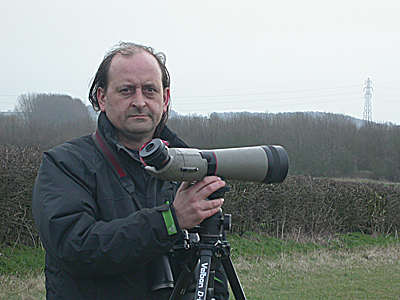 |
Dedication to my
particular haven of Eakring Flash, has put the area on
the county birding map, with a string of regular and
sought after species which include Richard's Pipit,
Firecrest and Spotted Crake to name but three. It's not
all about rarities here, common birds are meticulously
recorded on an almost daily basis and this forms part of
the overall birdwatching routine. Since I can remember, there was always a developing interest in wildlife during my earliest years. At the forefront of this development were birds and like so many children of "my day", it involved some limited egg collecting and bird nesting. I always had an uncanny ability to find the nests of many species and quickly learnt the most likely nesting sites of particular species, with Wrens being a particular favourite to find. |
|
| ............... | ||
| Like others, a wider interest in both flora and fauna gradually increased and during my Comprehensive school "sentence", I met someone who was to become a life-long friend and introduce me to breeding butterflies. It was an absorbing hobby (though time consuming) but also an extremely rewarding one. With independent mobility now at our fingertips, it was possible to broaden our horizons a great deal and to obtain species which until then, had only been available to us from entomological livestock suppliers. | ||
| ............... | ||
| Trips would see us making
collecting forays to Salcey Forest in Northamptonshire,
Wakerley Wood in Leicestershire, Bernwood Forest in
Oxfordshire and to some wonderful downland sites in the
Chilterns. Swyncombe Downs and Turville Heath, were both
wonderful places. Some glorious days were spent there and
most weekends seemed to provide absolutely stunning
weather. They were days which were capped by a tradition
of visiting the pub in Turville after a collecting
sojourn on the downs above it and then the obligatory
Little Chef stop along the A1. It was always late when we
arrived back home and the following day would be spent
setting up breeding cages and checking progress of the
previous day's catches. Many of our breeding species were housed in large flight-cages. For many, breeding was easy (though according to the books of the day, most unlikely in such housing) The fact was that a larger cage allowed normal behaviour from most species and many could be left to their own devices. The English Swallowtail became so ridiculously easy to breed, that we would be left with far too many larvae to manage and the whole flight-cage concept was a joy to experience. Nowdays, people can visit many similar butterfly farms across the country and enjoy these marvellous insects. |
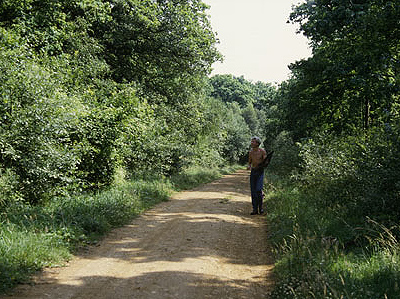 Gary Wilson netting butterflies at Salcey Forest in the early 1980's |
|
| ............... | ||
| This early
1980's period also saw the swapping of hobbies and in
return for my developing an interest in butterflies, I
opened up an Astronomical interest within my friend.
Unlike breeding butterflies (which remained a passion
until the mid 80's) our astronomical interest has
remained to this day. The subject has many aspects and
our particular favourite is the study and observation of
meteors. Meteor observing is still totally dominated by the amateur observer and probably always will be. Its also one of the few aspects of the science in which the amateur can still actually provide the few professional observers there are, with accurate and usable scientific data. There are probably no more than 400-500 amateur meteor observers world-wide. Even that figure may be slightly generous, so rare is this interest. It is though, an extremely absorbing hobby and yes, quite often very unsociable. One thing is for sure, there is nothing like being under the night sky on a Winter's night. |
||
| ............... | ||
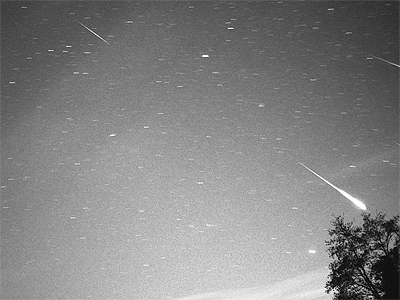 |
Meteor astronomy is
totally unpredictable and it's this which no doubt
creates a personal attraction to the hobby. It has
provided some wonderful memories, some absolutely
heart-stopping moments of excitement and most of all
enjoyment and release from the pressures of the modern
world. Our greatest night came in November 1998 when the Leonid meteor shower provided an unexpectedly early display of many bright meteors throughout the night. This came more than 16 hours before the predicted maximum and caught many experienced observers unawares. The following night saw much lower rates and much disappointment among the world's Press. All our watches are recorded on tape and it is still possible to sit and listen to recordings which date back to 1980, and to re-live any particular night. Such "chapters" of one's life are probably quite unique and of course personally much treasured. |
|
| ............... | ||
| The inception
of the Internet has made the world a much smaller place.
Back in the early 1980's, our only contact with other
meteor observers around the world, was third-hand
reports/articles published in the quarterly British
Meteor Society Bulletin. The information in it was useful
to us, but always about three months after the event.
With e-mail and the Internet, we now have the ability to
communicate and pass/recieve observational results to
people across the globe. Up to date information is now
there at the touch of a button. My working life has revolved around two jobs. For just under 11 years, I was a Craftsman Gardener with the Nottingham City Council and then for a similar period, a Print Finsher with a New Basford Printers. Working shifts at my second employer allowed the opportunity to increase my developing obsession for birdwatching which began in 1989. |
||
| ............... | ||
| At the start of 1990, I
began a series of year-listing "escapades"
within Nottinghamshire. After which my eventual intention
being to reach the 200 species' target for my county,
then the almost magical 250 species mark, which I finally
achieved in 2001 when Great Northern Diver finally
succombed to my county list addiction. Such an addiction to Nottinghamshire's birds, involves little interest in seeing anything more than a few hundred yards outside the county (not likely to fly over the border) and I have never taken my binoculars out unless I'm standing on Nottinghamshire soil. Perhaps my greatest twitchable find to come out of my year-listing days, was the Red-necked Phalarope at Hoveringham in May 1992. I also jointly held the year-list record with Phil Palmer in 1994, both sharing a 190 total before Phil eventually went on to beat it. Despite being obsessed with the county's birds (although I rarely bother twitching anything now) I do have a great interest in what actually does turn up elsewhere (the East Coast being a particular favourite) This is purely as an aid to predicting or hoping what could turn up in the county and in particular at my local patch at Eakring. |
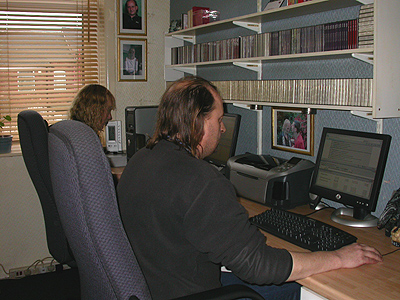 |
|
| ............... | ||
| After the
year-listing years, during which I developed the
reputation among'st birders for turning up almost
anywhere within Nottinghamshire, my transformation into
local patch watcher took many by surprise. Although
physically well known to many, I probably had another
reputation as being a rather secretive character. My
birding had been a purely singular hobby until I met Paul
Naylor at King's Mill Reservoir one very cold and windy
November morning, after which we left, then a Great
Northern Diver dropped in. That one meeting had the
affect of turning my attention to one particular site and
soon, my name became automatically associated with
"The Res". I learnt a lot during my four years birdwatching there, soon developing an obsessional interest in visible migration, something which still remains. The systematic counting of passage birds has also seen an increase during recent years at many local sites. It is (bar finding a gross rarity) the most exciting aspect of birdwatching. To see flock after flock of relatively common species is still something that I find almost awe-inspiring. After my surprising move from year-lister to patch-watcher, another move came as yet another surprise. |
||
| ............... | ||
| Moving to Eakring in late
1997, was an exciting prospect personally, enabling me to
study the birds in an area of agricultural farmland and
more importantly - a previously ignored part of the
county. The whole concept of finding the newly formed
Eakring Flash, monitoring it's development and the birds
it attracted was irresistable. A web site soon followed and within a year, the Eakring Birds Web Pages had attracted over a thousand visitors. After it's demise in 2000, a further year elapsed before the present Eakring Birds.co.uk went on-line. Now, regularly attracting over 150 visitors per week, the site is developing a reputation as having something different from many birding web sites, covering the area's birds in vastly more detail than others. That's not a fault of others, it's just my preference. The Internet is there to learn from and hopefully people visiting my website will do exactly that. Eakring Birds.co.uk also encompasses much of my character, showing the attention to detail of which I am duly proud. I am luckier than most, in having a great deal of time to devote to birdwatching. Probably that's why Eakring is mentioned so often on the county's birdline. |
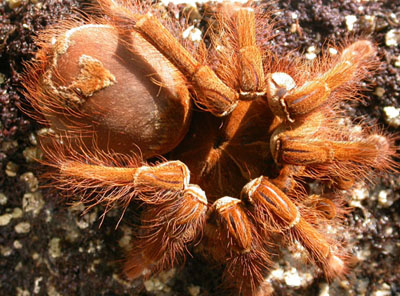 |
|
| ............... | ||
| Among several
other interests are the keeping of Tarantulas. Another
unusual hobby I suppose, but also another fascinating
one. Despite a great fear of house spiders, I am quite at
home with their hugely larger relatives. The fact that
they are kept in individual containers, probably also has
some psychological connection in my desire to keep
control of my fears. In May 2001 I left work at that time to become my wife's carer after an operation in the QMC during the late April of that year. Continued deteriation meant that in May 2002, she was admitted into King's Mill Hospital and remained there until shortly before Christmas of the same year. The first six weeks were spent defying death several times in ICU, but she survived and in the intervening period I was encouraged by many new-found friends who experienced the same emotions, to write a paper describing The potential physical and psychological affects on the Intensive Care Unit visitor. For those who have experienced any long-term patient visiting in an ICU or hospital ward, it has the ability to bring previously witheld emotions to the fore and has been described by many as a "powerful tool". |
||
| ............... | ||
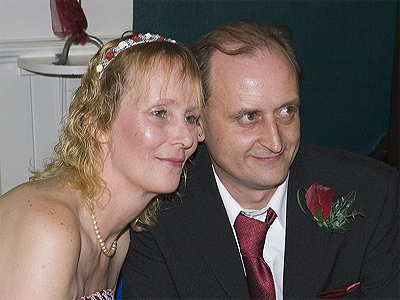 Our wedding in March 2006 |
Seven drafts later, the
finished article was eventually passed onto the Clinical
Psychologists and ICU staff at KMH, the consequences of
which are that it will now be used as a
teaching/instruction aid for training Psychologists.
Surprisingly this was the first work of it's kind to be
written anywhere in the world by a member of the public,
something those who experienced it found incredible.
After my wife's death at the end of April 2003, I
re-wrote it and then wrote about the affects of
bereavement entitled The potential physical and
psychological experiences affecting the bereaved -
a 12,000 word document which looks at the reasons behind
my thoughts and actions and those of other people's. It was through my current job as a care support worker that I met Dilys and we surprised many by getting married within eight months of meeting in March 2006. Dilys soon developed more than a passing interest in most aspects of wildlife, learnt to use the computer and began to assist in updating the website, entering data into spreadsheets and taking much of the work from me. |
|
| ............... | ||
| Moth trapping soon became an obsession and we now go out to Eakring on many nights during the course of a year. 2007 saw us trapping on just over 100 evenings, but we also spend most of our free time out and about, usually at Eakring, but also dropping in at our other favourite haunts such as Warsop Main Pit Top, Holborn Hill Plantation and Budby Common. I have been incredibly fortunate to find someone with whom I can share my interests and even more fortunate that she has an extremely keen eye and a knack of finding something rare. On her first-ever moth trapping session with me, the very first moth she caught with the net, turned out to be a Pale Pinion - a first Nottinghamshire record! | ||